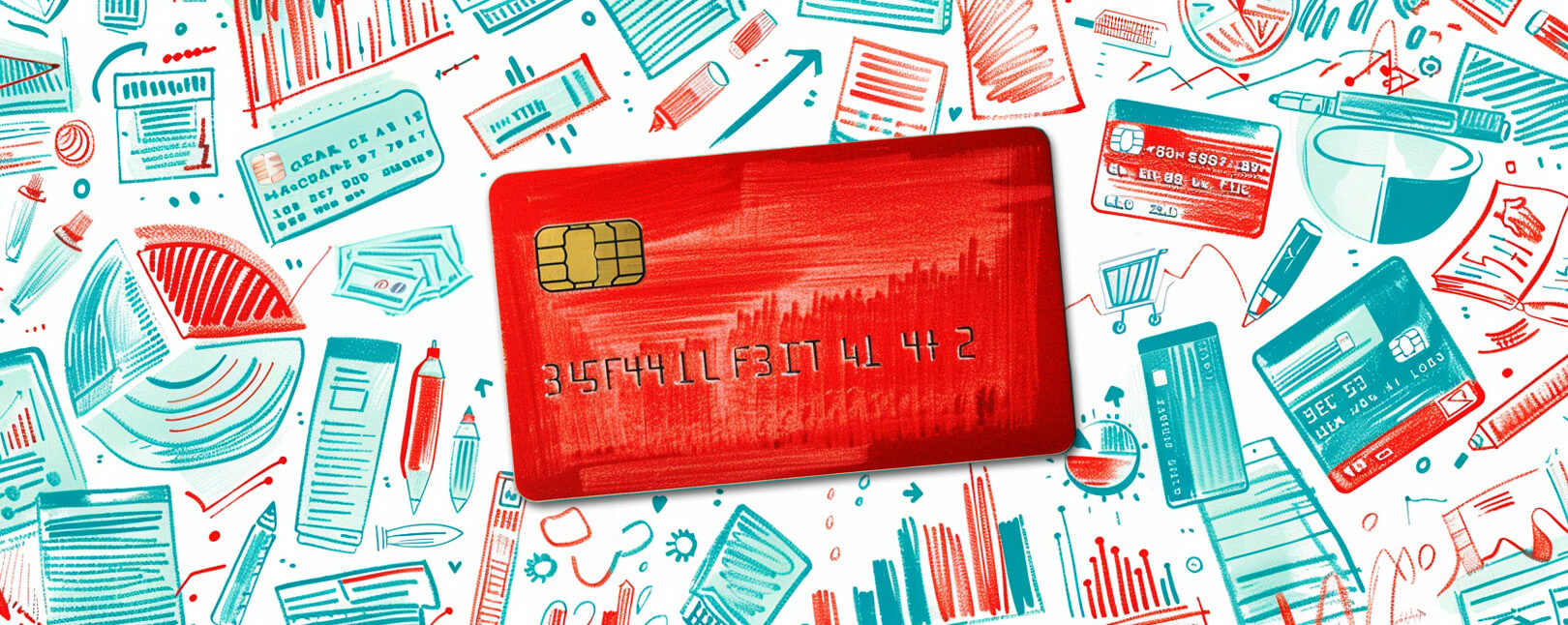24 Key Credit Card Fraud Statistics to Know for 2024
Have you been the victim of credit card fraud in the last year involving online purchases? Or, maybe you’re an online merchant who's seen a sudden uptick in fraud attempts?
In either case — it may be small comfort, but you’re not alone. Not by a long shot.
Global losses from payment card fraud are projected to reach $43 billion by 2026. And, according to eMarketer, card-not-present (CNP) fraud was responsible for 73% of card payment fraud losses last year. That’s an 8.5% increase over reported losses in 2022.
Virtually anyone can fall prey to fraudulent crimes, regardless of the victim's age, finances, educational level, gender, or geographic location. Even if you’ve never been targeted, it may just be a matter of time; over 1.03 million people were impacted by identity theft in 2023. Based on FBI Internet crime report data, the chances of becoming a victim of credit card fraud are roughly 1 in 26 in the US every year.
In this post, our goal is to provide a better picture of the situation. We’ll ask a few key questions, then offer answers backed by some startling credit card fraud statistics. You may be surprised by what you discover.
All that said, let’s start with the most obvious question.
Recommended reading
- Address Fraud: How Criminals Swap Addresses to Abuse Victims
- How do Banks Conduct Credit Card Fraud Investigations?
- What is Wardrobing? How Can Retailers Stop Refund Abuse?
- Scammers See Opportunity as March Madness Begins
- Man-in-the-Middle Attacks: 10 Tips to Prevent These Scams
- Card-Not-Present Fraud: How to Fight This Growing Threat
#1 | How Big is the Problem?
Reports show that, globally, the number of digital transactions suspected to be fraud attempts rose 5% in 2023. This follows a pattern of growth that saw volume grow by over 100% between 2019 and 2023. While the problem is global in scope, US consumers are the primary target, being the source of more than one-third of card fraud losses.
As the credit card fraud statistics outlined below show, this is a massive problem for both cardholders and merchants:
- 59% of eCommerce companies have noticed an increase in online payment fraud. (source: Exploding Topics)
- In the last 12 months, 96% of US companies were the target of at least one fraud attempt. For 90% of those companies, at least one attack was successful. (source: Trustpair)
- 10% of the US adult population fall victim to identity theft every year. As many as 80% of the US credit cards currently in circulation may have been compromised. (source: Merchant Cost Consulting)
- The FBI reported receiving over 880,400 complaints in 2023, with potential losses exceeding $12.5 billion. That represents nearly a 10% increase in complaints and a 22% increase in losses compared to 2022. (source: FBI.gov)
- Globally, 4.6% of all customers’ digital transactions were suspected to be fraudulent last year. The total volume of suspected digital fraud attempts increased by 80% between 2019 and 2022. (source: TransUnion)
#2 | How Much Does Fraud Really Cost?
There are a variety of indirect long- and short-term costs from fraud. For merchants, the most obvious metric is the direct financial impact that fraud attacks have. Current online credit card fraud statistics paint a sobering picture of the threat currently facing businesses and their customers:
- Total global losses from payment cards hit $34 billion in 2022. (source: Clearly Payments)
- Actual losses resulting from fraud came to roughly $127.5 billion, when accounting for lost revenue, merchandise, fees, added overhead, and lost productivity. (source: LexisNexis Risk Solutions)
- Merchants are expected to lose over $362 billion globally to payments fraud within the next 5 years. (source: Primer)
- In the United States alone, the direct costs of credit card fraud losses are projected to exceed $165.1 billion over the next 10 years. That’s not accounting for any of the additional losses outlined above. (source: Bankrate)
#3 | What Are the Most Common Forms of Fraud?
Credit card fraud involves making purchases with stolen account data. There are many different ways to accomplish this, though.
Some of the more common types of scams and credit card theft tactics are revealed in the credit card fraud statistics we’ve outlined below. For instance, we can see that credit card fraud is a leading source of identity theft, and new account fraud is now far more common than account takeover:
- Of the 1.036 million reports of identity theft in 2023, credit card fraud was the most common method, with 426,000 reports. (source: Motley Fool)
- There were 363,092 reports of fraud involving the setup of new accounts, compared to 32,204 reports of fraud using existing accounts. (source: Credit.com)
- Synthetic fraud, or the use of stolen personal information to create accounts for non-existent cardholders, was the fastest-growing type of digital fraud globally. There was a year-over-year increase of more than 14% in attacks between 2022 and 2023. (source: Business Insider)
#4 | Where Do Fraudsters Get Stolen Data?
Fraud is not a new problem. So, where are modern fraudsters getting the data to pull off their scams? Hasn’t anything been done to try and stop them?
Phishing schemes are still the most widely used method for commandeering information from individuals. Last year, phishing was the basis for 298,878 fraud complaints to the Internet Crime Complaint Center. That’s more than five times the number of personal data breaches reported, which was the next highest data source on the list.
That said, the cheapest unregulated source of stolen data is, by far, the dark web. Hackers will typically steal a massive trove of personal payment information through data breaches. The attacker then resells that information online; often for just a few dollars per credit card. While they may not commit the actual fraud, they directly enable the process by selling the millions of records compromised through data breaches every year:
- There were 443 publicly disclosed data security incidents (breaches) carried out in December 2023. That’s more than double the number of attacks conducted in the previous month. (source: IT Governance)
- In 2023, a cyberattack took place every 39 seconds, which translates into over 2,200 cases per day. In contrast an incident occurred every 44 seconds in 2022. (source: Watchguard)
- The average price of a cloned Mastercard, with PIN included, purchased on the dark web in 2023 was $20. For complete, verified credit card details, with a known account balance up to $5,000, the average price was $110. (source: PRIVACY Affairs)
- 83% of US companies saw an increase in cyber fraud attempts on their organization in the past year. (source: TrustPair)
- In 2023, the US saw 22,229 reports of identity theft involving the identities of persons under the age of 19. This represents more than $15 million in fraudulent losses. (source: GOBankingRates)
- In cases of identity theft involving minors, the fraudster was the victim’s parent in more than half of cases. (source: GOBankingRates)
#5 | Are Cardholders Ever at Fault?
Cardholders can be victims of criminal activity. But, they’re also helping perpetuate the problem.
There are a number of ways in which cardholders can engage in first-party fraud. For example, cardholders can hurt merchants by abusing the return process. They can engage in practices like chargeback abuse (or “friendly fraud”). The credit card fraud statistics outlined below give a hint of the extent of the problem:
- 75% of the average merchant's chargebacks could be the product of friendly fraud. (source: Visa)
- For every $1 million in sales, the average retailer incurs $165,000 in merchandise returns; more than one in ten refund requests are cases of return fraud. (source: NRF)
- Nearly three-quarters of cardholders consider disputing a charge to be a valid alternative to a refund. (source: Chargebacks911)
- 25% of eCommerce shoppers are willing to ask for a refund, even when they plan on keeping the product. (source: Exploding Topics)
- 35% of consumers feel that no fees or penalties should ever be imposed on cardholders for disputing a charge instead of requesting a merchant refund. (source: Chargebacks911)
- 36% of cardholders feel that, if fees are to be imposed as part of the dispute process, the retailer should be the one responsible for paying them. (source: Chargebacks911)
Fraud Hurts Everyone
As addressed above, merchants will likely be liable for the fraud. The issuer will refund the cardholder, but then send the merchant the bill. They’re also out the cost of the merchandise itself, plus taxes, shipping fees, and so on.
But, while merchants bear the cost burden of fraud directly, the problem ultimately affects everyone. Whether they’re directly connected to the fraud or not, the economic cost of fraud spreads across the entire retail landscape.
Victims of fraud may eventually be reimbursed, but it can take time to fully resolve the issue. The money (or available credit) can be tied up for weeks or months. Victims also face the heavy task of tracking down and double-checking all instances of altered personal records, like changed addresses, passwords, and so on. The resulting stress and emotional distress will also be a factor.
Finally, there is something of a “butterfly effect”: fraud from criminals and consumers become merchant losses. Merchants raise prices, trying to recoup those losses. As a result, retail prices increase for all consumers.
Fraud is Real, but it Can be Handled
From the merchant’s perspective, it doesn’t matter if fraud comes from criminal attacks or cardholder abuse. The end result is more chargebacks, lost revenue, and threats to your business.
Chargebacks911® are the industry’s leading experts in chargeback management and mitigation. We offer innovative technologies and customizable strategies designed to help you detect and resolve issues before they turn to chargebacks.
Don’t become another statistic. Contact us today to learn more about our risk-free fraud solutions.
FAQs
What are the statistics of credit card fraud?
Over 1.03 million people were impacted by identity theft in 2023, with potential losses exceeding $12.5 billion. Merchants are expected to lose over $362 billion globally to payments fraud within the next 5 years. In the United States alone, credit card fraud losses are projected to exceed $165.1 billion by 2034.
How often does credit card fraud get prosecuted?
In less than 1% of cases, according to most sources. Credit card fraudsters are the least likely to be caught. Due to chargeback protections, cardholders are responsible for little to none of the fraudulent transactions. The criminals, however, will likely never be caught.
Who eats the cost of credit card fraud?
In almost all cases, either the bank or the merchant involved will have to pay; which one depends on the specific circumstances. For card-present purchases, it is typically the bank who reimburses the customer and assumes the financial loss. Even so, the bank may still try to prove that the merchant was negligent (wasn’t following proper security measures or verifying the identity of the cardholder, for example) and will attempt to recover the cost from the business.
In card-not-present situations, however, the reverse is true. Merchants have no chance to examine the physical credit card, check buyer identification, or rely on the built-in security of a chip-enabled card. The liability of accepting a fraudulent CNP transaction, therefore, is shifted to the merchant themselves. If a merchant accepts an order online that is later found to be fraudulent, the merchant must refund the customer.
How risky is credit card fraud?
It’s highly unlikely that a fraudster will be caught, and even less likely they will be prosecuted. For criminals, credit card fraud carries a low risk. If a cardholder knowingly disputes valid transactions, there is a greater risk of the perpetrator being caught.
Who bears the risk of credit card fraud?
Generally speaking, it is the bank that takes on the risk when they issue a credit card to a cardholder. However, both merchants and consumers are expected to maintain reasonable standards to protect purchases. If the bank can prove negligence, they may be able to shift part or all of the liability. Again, accepting eCommerce payments is riskier, so merchants who offer online shopping assume the lion’s share of the risk.














